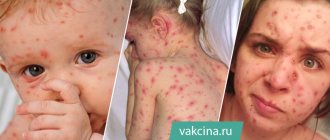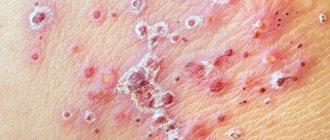Definition of disease
Measles is an acute infectious disease caused by an RNA virus of the Morbillivirus genus.
It is characterized by low stability in the external environment. At room temperature it remains active for 24–48 hours. It dies quickly when dried, heated to 50°C, or exposed to ultraviolet radiation. The first detailed descriptions of the signs of measles appeared in the 17th century, although the disease itself has been well known to mankind since ancient times. In those days, the disease was often called the “childhood plague”, since it was practically not observed in adults. This was explained by the fact that more than 90% of people suffered the infection at an early age - from infancy to 10 years.
Measles is easily transmitted from one person to another, which is why epidemics have occurred regularly in the past. In many children, the disease progressed with the development of serious complications that led to death.
The measles virus was isolated and described in 1954. Nine years later, the first measles vaccine was created. By 1990, about 80% of the population had been vaccinated against measles in most countries. Thanks to this, a steady decline in the number of cases began. If in 1983 about 4 million cases of the disease were registered in the world, then in 1990 - 800,000¹. The mortality rate has also decreased significantly.
An unvaccinated child came into contact with a person with measles. What to do?
“An unvaccinated child who has not reached vaccination age (3-12 months) is given immunoglobulin. This must be done no later than 3-5 days from the moment of contact with the patient. A child over 12 months of age who has not previously been vaccinated for any reason or has been vaccinated once is given post-exposure prophylaxis with a live measles vaccine - within 72 hours of contact with the patient.”
Vanina Yulia Evgenievna
expert
Children's clinic "RebenOK", pediatrician
Measles continues to be a serious problem today. This infection has “matured” and now often affects not only children, but also adults. The last major measles outbreak was reported in almost all countries in 2017–2018. Experts from the World Health Organization largely attribute its occurrence to a decrease in the level of vaccination of the population. This was largely facilitated by the “anti-vaxxer” movement.
The WHO called population distrust in vaccination in 2021 one of the global problems of modern health care.
Measles symptoms
The clinical picture of measles infection includes:
- incubation period - the time from the moment of infection until the first signs of illness appear;
- prodromal period - the appearance of general symptoms that are characteristic of many viral diseases;
- skin rashes;
- convalescence - recovery.
The incubation period lasts from 7 to 17 days. It can increase to 21–28 days in the case of prophylactic administration of gamma globulin.
Measles is characterized by an acute onset. Body temperature rises and signs of intoxication appear:
- headache;
- general weakness;
- decreased appetite;
- sleep disorders.
After a few hours, the listed symptoms are accompanied by a dry cough, runny nose with mucopurulent discharge. Conjunctivitis develops - inflammation of the mucous membrane of the eyes. Bright light causes discomfort in the eyes. This symptom is called photophobia. Upon examination, redness and swelling of the pharyngeal mucosa are revealed, and enlarged lymph nodes are possible.
Figure 1. Symptoms and complications of measles. Image: Artjita/Depositphotos
In some cases, signs of dyspepsia may be observed with measles:
- nausea, vomiting;
- softening of feces;
- belching air;
- heartburn.
The temperature lasts from 3 to 5 days. Then it decreases, and the person’s condition improves. But the next day the temperature rises again, general weakness, cough, runny nose and photophobia intensify. When examining the oral cavity at this moment, you can detect a specific symptom of measles - Belsky-Filatov-Koplik spots. They are located on the mucous membrane of the cheeks in the area of small molars and take on the appearance of “semolina” - small whitish dots that slightly rise above the surface of the mucosa. At the same time, small red spots of irregular shape - enanthema - become clearly visible on the surface of the soft and hard palate. With the appearance of skin rashes, enanthema and Belsky-Filatov-Koplik spots disappear.
With the beginning of the period of rashes, body temperature rises even more, the severity of symptoms of intoxication and catarrhal manifestations intensifies. The main sign of measles infection is a clear sequence of occurrence of the rash. On the first day it appears on the head and neck, on the second it goes down to the shoulders and torso, on the third it covers the skin of the limbs.
"Hello" from measles
“Having measles can affect a person’s health after several years.
The formation of chronic encephalitis (slow infection of measles in the central nervous system) is possible. This condition is accompanied by headache, lethargy, fatigue, and memory impairment. There may be a decrease in intelligence and the appearance of epileptic seizures.” Vanina Yulia Evgenievna
expert
Children's clinic "RebenOK", pediatrician
Elements of the measles rash appear bright pink or red, slightly raised above the surface of the skin. They can merge, forming quite large figures, separated from each other by areas of unchanged skin.
Approximately 7–10 days after the appearance of the first signs of the disease, the period of convalescence begins. The elements of the rash turn pale, and light brown spots remain in their place, which persist for 5–7 days. Regression of rashes occurs in the reverse order of their appearance, that is, it goes from bottom to top. Body temperature decreases, general condition quickly improves.
During the period of convalescence, there is a significant weakening of the body's defenses. As a result, the risk of developing other viral or bacterial diseases increases dramatically.
How to distinguish measles from other diseases
Measles must be differentiated from other infectious diseases that also occur with the appearance of a skin rash and, above all, from rubella (Table 1).
Table 1. Main differences between measles, rubella, scarlet fever
| Sign | Measles | Rubella | Scarlet fever |
| Initial symptoms | Intoxication and catarrhal symptoms intensify over 2–4 days | Minor catarrhal signs, rash | Increased body temperature, symptoms of acute sore throat, possible enlargement of the submandibular lymph nodes |
| Time of appearance of the rash | 4–5 days of illness | The first day of illness, extremely rarely on the second day | 1–2 days of illness |
| Nature of the rash | Large, often its elements rise slightly above the surface of the skin - maculopapular | The appearance of small red spots - small spotted. | Represented by small dots |
| Size of rash elements | Quite large. Can reach 10–20 mm in diameter, often merging with each other | The diameter of the rash elements does not exceed 5–10 mm | Very small, no more than 2 mm in diameter |
| Order of rashes | Characterized by a clear sequence of rashes | Over the entire body at the same time | Immediately over the entire surface of the body |
| Location of the rash | Descends from top to bottom. First appears on the head and neck, then on the torso, and on the third day on the limbs | All over the body. The maximum concentration of rashes is observed on the face, back and buttocks, extensor surfaces of the arms and legs | Favorite localization sites are natural folds of the skin, lateral surfaces of the torso, flexor surfaces of the upper and lower extremities |
| Rash brightness | Brown or red | Pale pink color | Bright |
| Changes in the oral mucosa | The presence of Belsky-Filatov-Koplik spots, enanthema on the soft and partially on the hard palate | The oral mucosa is not changed. Rarely can you see small red spots on it | The mucous membrane is hyperemic - bright red |
Koplik's spots.
This is one of the manifestations of measles: red spots with a white center that appear in the mouth. Koplik spots usually appear before the rash appears on the face and body and may last only a few hours.
READ ALSO: Treatment of eczema - the most effective creams, ointments, tablets and traditional medicine recipes
Occasionally, Koplik's symptom may appear after a rash on the body.
Treatment of measles
Measles can be treated at home in most cases. Hospitalization is indicated only in severe cases of the disease and the development of complications.
Important!
Bed rest is recommended throughout the entire period of fever. It is important to avoid bright light and maintain good oral hygiene.
Treatment is aimed at preventing complications and relieving symptoms of the disease. To eliminate the manifestations of intoxication, you need plenty of warm drinks - still mineral water, rosehip infusion, herbal teas, fruit juice, compote. In severe cases, detoxification therapy may be required - intravenous administration of glucose and saline solutions, taking vitamins. According to indications, antihistamines, expectorants and non-steroidal anti-inflammatory drugs are used.
Interferons and normal human immunoglobulin are used in the treatment of severe forms of measles infection. They are most effective when prescribed in the early stages of the disease. Treatment of bacterial complications is carried out with broad-spectrum antibiotics.
Figure 2. Measles in the facts. Sources: WHO and Israeli Ministry of Health
Measles in an adult and a child - differences
The clinical picture of measles in children and adults differs in characteristic features, which are presented in Table 2.
Table 2. Differences in the clinical picture of measles infection in children and adults³.
| Sign | Adult | Child |
| Duration of catarrhal period | Lasts 6–8 days. Intoxication and temperature reaction are more pronounced than in children | Duration 3–5 days. Manifestations of intoxication are more smoothed out than in adults |
| Belsky-Filatov-Koplik spots | Lasts up to 3–4 days from the onset of the rash | Usually disappear when a skin rash appears or within the first two days thereafter |
| Rash | The elements of the rash merge with each other to form large elements, and hemorrhagic rashes—small hemorrhages into the skin—may appear. The phasing of rashes may be disrupted | The rash is less likely to form large elements |
Measles in children occurs in a milder form than in adults. So far, experts cannot clearly explain this phenomenon. Perhaps it is associated with the peculiarities of the child’s immune response. In children, the thymus gland actively functions, in which the differentiation of special cells - T-lymphocytes - occurs. They play an important role in protecting the body from various microorganisms, including viruses. But after 5–6 years, the activity of the thymus gland decreases, and by 30–40 years it is almost completely replaced by adipose tissue and ceases to perform its functions.
In addition, in young children the number of lymphocytes in the blood prevails over the number of neutrophils. At the age of 5–6 years, the so-called crossover of the leukocyte formula occurs. As a result, the content of neutrophils in the blood increases and the number of lymphocytes decreases. Neutrophils provide protection against bacterial infections, and lymphocytes provide protection against viral infections. Perhaps this circumstance is associated with a more severe course of measles in adults.
Lifetime immunity
“Children who have had measles or received a full course of vaccination develop lasting immunity to this disease.”
Vanina Yulia Evgenievna
expert
Children's clinic "RebenOK", pediatrician
Chicken pox
Symptoms.
The child’s temperature rises to 37.5-38.0 C, and almost immediately a characteristic blistering rash appears. Moreover, the first spots are usually visible at the junction of the scalp and forehead; in subsequent days, the rash spreads to the entire body. Only a doctor can reliably determine the nature of the rash and make a diagnosis! Therefore, the best thing you can do for your child is to call a pediatrician. This infection occurs easily in young children (up to 5-6 years old). At older ages, the disease is more severe, often with symptoms of general intoxication. The disease is caused by the herpes virus type 3, it is very contagious, so if someone in a kindergarten group gets sick, then everyone who was in contact will get sick.
Complications of measles
The measles virus suppresses the activity of the human immune system. This causes an increased risk of developing many infectious and inflammatory complications, which can be caused by both viruses and bacteria.
Measles is most often complicated by the development of otitis media (7–9% of cases) and pneumonia (1–6% of cases)⁴. In young children, measles infection provokes the development of laryngitis, an inflammation of the larynx. Against this background, a condition of false croup often develops, which is accompanied by attacks of suffocation and requires emergency medical care.
Dangerous complications of measles are:
- meningitis - inflammation of the pia mater;
- meningoencephalitis is an inflammatory process that affects the brain and its soft membrane;
- polyneuritis is a lesion of the nerve trunks, which causes paralysis and paresis of the lower extremities.
Delayed complication
One of the most dangerous complications of measles can develop several years after the illness. This is brain atrophy - the gradual death of neurons and the destruction of connections between them. The clinical picture unfolds slowly. Initially, changes in character are noted, then regression of brain functions becomes noticeable, and convulsive seizures may occur. The risk of developing brain atrophy is significantly higher in children who had measles before the age of 12 months.
Routes of infection and risk groups
The source of measles infection is an infected person. Virus shedding begins 1–2 days before the first signs of illness appear and lasts 4 days from the appearance of skin rashes. Sometimes a person can remain infectious to others for longer - up to 10 days from the moment the rash appears. With measles infection, asymptomatic carriage is not observed.
Figure 3. What an unvaccinated person should do after contact with a sick person. Source: Israeli Ministry of Health
Infection occurs through airborne droplets during communication, sneezing and coughing. Contact and household transmission of infection for measles is excluded, since the pathogen is extremely unstable in the environment.
During illness in pregnant women, the measles virus can penetrate the placental barrier and infect the fetus. This route of transmission of infection is called transplacental.
Susceptibility to measles is close to 100%. And if a person has not previously had measles and has not received a vaccination, then if he comes into contact with a sick person, he will almost certainly get sick.
After suffering from the disease, lasting immunity is formed for life.
Before the start of mass immunization, the main characteristics of the epidemiological process for measles were:
- massive outbreaks of the disease that recurred at intervals of 2–5 years;
- the peak incidence occurred in the winter-spring period;
- the infection was predominantly in children aged 1 to 5 years².
Currently, there is a sharp decline in cases of the disease; there is no pronounced seasonality or frequency. Measles continues to be considered a childhood infection, since it is most often diagnosed in children under 10 years of age. But in the overall structure of cases, there is an increase in the number of adolescents and adults.
First signs
The rash in pictures of rubella is often mistaken for the primary signs of the disease, but several pre-existing conditions allow one to suspect something is wrong. So, a few days before the obvious manifestation of symptoms, the patient begins to experience weakness, malaise, and becomes slower. Body temperature rises to around 38.
Vaccination
In Russia, routine vaccination against measles is carried out simultaneously with vaccination against other childhood infections - mumps and rubella. The first vaccination is given to babies at the age of 12 months. At this time, the protective antibodies they received from their mothers almost completely disappear in their body. Revaccination is performed before the child enters school - at 6 years of age.
Routine measles vaccination is also carried out for all adults under 35 years of age, if they have not previously had measles and have not been vaccinated.
The best protection against measles is vaccination. Photo: Amaviel/Depositphotos
The measles vaccine is usually well tolerated. There may be side effects - a slight increase in body temperature and mild soreness at the injection site.
Revaccination - once every 10 years
Some studies show that 10 years after vaccination, the level of antibodies in the blood of 30-40% of people decreases so much that the body can no longer provide protection against measles¹. Therefore, adults are recommended to have a booster vaccination every 10 years. It is especially important for workers in the fields of education, public utilities, social protection, and healthcare.
Types of vaccines
When immunizing the population, different types of vaccines can be used. Differing from each other in the type of viruses included in the immunobiological preparation, they are divided into monocomponent, two-component and three-component. The first two involve administering vaccines to different parts of the body. Today, children and adults have the opportunity to be vaccinated with both domestic and imported drugs. The quality of the serum and the result are no different.
Ervevax (Belgium)
A monovaccine used to prevent the development of rubella. It includes the highly attenuated strain Wistar RA 27/3, as well as neomycin B sulfate - no more than 25 µg per dose of the drug. The seroconversion rate (production of antibodies by the body) of such an immunobiological drug is 100%. Specific immunity persists for 16 years after the last vaccination.
Ervevax is available for administration on the same day when the DPT, DPT, polio, measles, and mumps vaccinations will be administered. The main thing is to use different syringes for each drug containing the virus, and inject the vaccines into different parts of the body. Patients who received immunoglobulins are allowed to undergo immunization with such a vaccine 3 months after treatment. If human blood products were administered less than 14 days after vaccination, the latter should be repeated.
Prevention of rubella in children with the Ervevax vaccine can begin at 12 months. As for immunization of patients with a history of seizures, it is recommended that they be vaccinated from 2 years of age. The immunization procedure should be carried out with extreme caution in people prone to allergies. Vaccination is not allowed for patients with primary/secondary immunodeficiency, acute diseases and chronic diseases in the acute stage, and pregnant women.
Measles cultural live dry vaccine (Russia)
A monovalent vaccine aimed at combating measles. It includes a virus (~1000 tissue cytopathogenic doses), as well as a stabilizer, gentamicin sulfate - no more than 0.5 μg per dose of the drug. The development of stable immunity to measles after vaccination with such a monovaccine reaches its peak 3 to 4 weeks after immunization.
The vaccine is completely safe and meets WHO recommendations.
Immunization with such a vaccine can be carried out with other NKPP vaccinations. In particular, it allows parallel immunization with the prevention of hepatitis B, whooping cough, diphtheria, polio, and other types of disease. After treatment with immunoglobulins, measles vaccination should be done after 3 months. After immunosuppressive therapy - no earlier than 3-6 months after its completion.
Routine vaccinations with the monovaccine are given to patients 12 months of age. Children who were born to mothers previously unvaccinated against this disease are vaccinated at 8 months. Further, according to the recommendations of the schedule of preventive vaccinations. Persons with a temporary medical exemption from vaccinations are subject to immunization after the removal of contraindications. Among the latter are pregnancy, immunodeficiency conditions, blood diseases, and oncology.
Mumps-measles vaccine (Russia)
A two-component vaccine used as part of the immunization of the population against measles and mumps. It contains the causative agents of the virus of the two above-mentioned diseases, as well as a stabilizer and gentamicin sulfate - no more than 0.5 µg per dose of the drug. The required level of antibodies for the administration of such a drug reaches its maximum values 3–4 weeks after vaccination. Stable immunity to diseases lasts for 10 years. Afterwards revaccination is required.
Immunization using such a vaccine can be carried out on the same day as DTP, ADS vaccinations, prevention of polio, hepatitis B, rubella, influenza, Haemophilus influenzae. Administration of other live vaccines is allowed after 1 month (in order to prevent the risk of drug inactivation). In cases where it is necessary to perform a Pirquet test, it is performed either together or 6 weeks after mumps-measles vaccine prophylaxis. As for human immunoglobulin preparations, their use is resumed after 2 months.
Vaccination against measles and mumps can be given to children from 12 months. In this case, it should be temporarily abandoned during the period of increased incidence of serous forms of meningitis. It should be remembered: the mumps-measles vaccine has a number of medical contraindications. These include pregnancy and breastfeeding, disorders of the immune system, allergic reactions to aminoglycosides, chicken and/or quail eggs.
Priorix (Belgium)
A three-component vaccine that protects the body from measles, rubella, and mumps. It contains the Schwartz strain, strain RIT 43/85, strain Wistar RA 27/3, as well as neomycin B sulfate - no more than 25 µg per dose of the drug. According to clinical trials, Priorix has high seroconversion rates.
So, in particular, antibodies to rubella are observed in 99.3%, to measles - in 98%, to mumps - in 96.1% of patients vaccinated with a vaccine containing three strains of the disease.
Priorix can be used in parallel with the DPT, DPT, polio, hepatitis B, Haemophilus influenzae vaccines. The main rule is not to allow drugs to be mixed in one syringe, and to place vaccinations in different places. Immunization using such a vaccine can be carried out both after previous vaccination with a combination vaccine, and after vaccination with monovalent drugs. If you need to take immunoglobulins afterwards, you should wait 2 weeks. Otherwise, the MMR vaccination will not have the desired effect on the body of the person being vaccinated.
In accordance with the NKPP, Priorix is initially administered to patients for 12 months. Revaccination is carried out at the age of 6 years. Further, every 10 years after the last vaccination. The option of using the vaccine during breastfeeding is allowed. It is strictly forbidden to use it for vaccination of patients with immunodeficiency conditions, hypersensitivity to neomycin, chicken egg white.
Diagnosis of measles
Catarrhal symptoms, the appearance of Belsky-Filatov-Koplik spots and enanthema, the characteristic stages of the spread of skin rashes are the main signs that allow the doctor to make the correct diagnosis. To confirm it, the type of virus is determined using the polymerase chain reaction method. The material for analysis - a swab from the nasal or pharyngeal mucosa - is taken 1-3 days after the appearance of the rash. An enzyme immunoassay, which detects antibodies to the virus in the blood, can also confirm the diagnosis. These laboratory research methods are rarely used in clinical practice, only in the case of an atypical course of the disease and difficult diagnosis.
A general blood test for measles reveals changes that are characteristic of viral diseases:
- slight leukopenia - decrease in the number of leukocytes;
- an increase in the erythrocyte sedimentation rate indicates an active inflammatory process;
- lymphocytosis - increased level of lymphocytes.
When bacterial complications occur in the blood, the number of leukocytes increases - leukocytosis occurs, and the content of neutrophils increases.
In case of measles, a biochemical blood test and a general urine test must be performed. They help to promptly identify possible complications from the liver and kidneys.
If indicated, other types of laboratory and instrumental studies are also carried out:
- electrocardiography;
- chest x-ray;
- cerebrospinal fluid analysis.
Rubella.
Symptoms.
Rubella begins with an enlargement of the occipital lymph nodes, an increase in temperature to 38-39.0 C. A little later, a runny nose and sometimes a cough appear. A rash appears 2-3 days after the onset of the disease. Rubella is characterized by a pinpoint, pink rash that begins with a rash on the face, neck, and then spreads throughout the body. The rash can remain on the body from several hours to 2-3 days, and then disappears without a trace. Children tolerate the disease without consequences.
The rubella virus is dangerous primarily for pregnant women, as it leads to irreversible developmental disorders of the fetus. In addition, rubella is very easy to get sick - just spend some time indoors with a sick person. Therefore, for the safety of expectant mothers, vaccination is included in the national vaccination calendar.
Complications practically do not occur. After the disease, a strong immunity is developed, and recurrent disease is very rare.
Classification
Measles can be very severe and require emergency care. It is important to know that the disease can be not only typical, but also atypical:
- Mitigated (weakened) measles. The disease develops in people who were administered anti-measles gamma globulin at the very beginning of the incubation period for the purpose of prevention. It is less common in previously vaccinated individuals who have not developed a full immune response. In this form of the disease, intoxication and catarrhal symptoms of measles are mild, the rash is faint and not abundant, Belsky-Filatov-Koplik spots are often absent.
- Abortion measles. It begins in the same way as a typical form of measles. But the temperature lasts no more than two days. Skin rashes are observed only on the head and torso and do not affect the limbs.
- Hemorrhagic measles. An extremely severe form of the disease that can be fatal. It is characterized by a rise in body temperature to very high values, severe intoxication, and the appearance of hemorrhages on the skin and mucous membranes. Blood may appear in the urine - hematuria.
- Hypertoxic measles. Body temperature rises to 40–41°C. The general condition is rapidly deteriorating. Signs of cardiovascular failure appear and increase - decreased blood pressure, a sharp increase in the number of heartbeats, pale skin, cold sweat. It is possible to develop neurotoxicosis - a toxic lesion of the central nervous system. Its signs are headache, nausea, repeated vomiting, disturbances of consciousness, and convulsions³.
Measles can be very severe and fatal. Photo: PHIL CDC
Parotitis
People also call it “pig”. This childhood viral infection is characterized by acute inflammation in the salivary glands. Infection occurs by airborne droplets. “Mumps” begins with an increase in body temperature to 39C, severe pain in the ear area or under it, aggravated by swallowing or chewing. At the same time, salivation increases. Swelling in the upper neck and cheek area increases quite quickly; touching these places causes severe pain in the child. This disease itself is not dangerous; unpleasant symptoms disappear within 3-4 days. However, quite often mumps ends in inflammation in glandular organs such as the pancreas and gonads. Pancreatitis in some cases leads to diabetes mellitus. Inflammation of the gonads (orchitis) is more common in boys. This significantly complicates the course of the disease, and in some cases can result in infertility. In particularly severe cases, mumps can be complicated by viral meningitis, which is severe but not fatal. Given such a number of possible complications, vaccination against mumps has been included in the national calendar.
Prognosis and prevention
With uncomplicated measles, the prognosis is favorable. The disease ends with complete recovery with the formation of stable lifelong immunity. After the rash disappears, no cosmetic defects remain on the skin. If measles meningoencephalitis occurs, the prognosis may become unfavorable. A particularly difficult course of measles is observed in people with HIV infection. In them, the disease often takes severe forms, is accompanied by the development of serious complications and often ends in death.
The best protection against measles is routine vaccination. A healthy person (if he has not had measles and is not vaccinated) is given emergency prophylaxis after contact with a sick person. It can be done in two ways:
- vaccination with live measles vaccine - carried out within the first 72 hours after contact;
- introduction of normal human immunoglobulin - the injection is given within the first five days from the moment of contact with the patient.
Emergency prevention is especially important for children under 5 years of age and adults with weakened immune systems.
To prevent the spread of measles, children from organized groups are separated for 17 days. The countdown starts from the moment the sick child is isolated. If gamma globulin is administered to children, the quarantine period is increased to 21 days.
Infectious mononucleosis.
With mononucleosis, rashes appear in approximately 10% of patients. Moreover, the rash immediately covers the entire body (with measles, remember, it spreads from top to bottom).
READ ALSO: Pimples on the genitals: what causes them and how to treat them
If a patient with mononucleosis received a penicillin antibiotic (this is a medical error, alas, not uncommon in our area), the likelihood of a rash increases to 90%. This rash is called ampicillin and indicates an allergy to the antibiotic.
Sources
- Measles. Wikipedia
- Timchenko V.N., Kaplina T.A., Bulina O.V. and others. Current problems of measles infection. Pediatrician, 2021. T. 8. No. 3. pp. 120–129.
- Yaremushkina Y.M., Vdovina E.T., Kotiv S.I., Kuskova T.K. Algorithm for diagnosing measles in a complex epidemic situation. Analysis of clinical data // Infectious diseases: news, opinions, training. No. 4. 2015
- Ivanova I.A., Ponezheva Zh.B., Kozlova M.S., Vdovina E.T., Tsvetkova N.A. Features of the course of measles in adults. Medical scientific and practical portal “Attending Physician”. 2021
Briefly about the important
A disease with a seemingly ridiculous name is actually extremely dangerous. The rubella virus affects every cell of the body, without exception, and can also cause a number of serious side diseases. This material contains the most important information about rubella in adults and children - about development, symptoms, complications, treatment. And, of course, you can see visual, detailed photos of rubella in adults and children.









